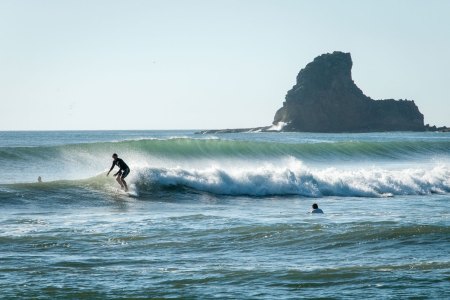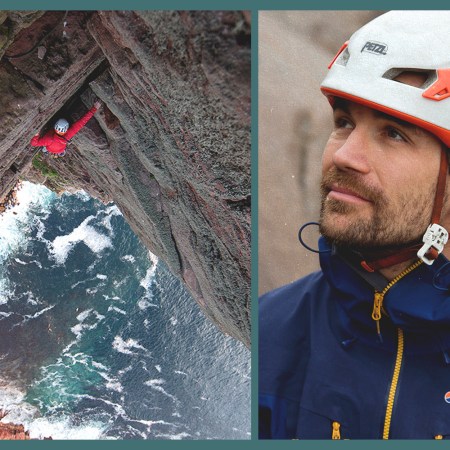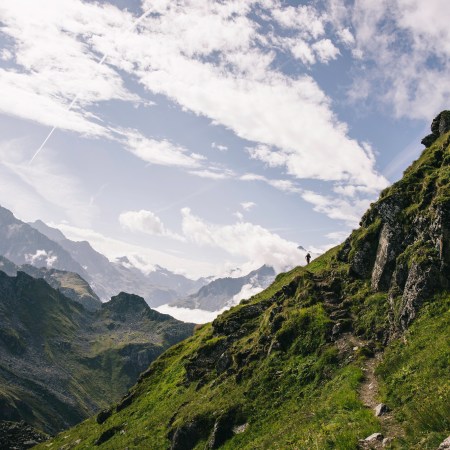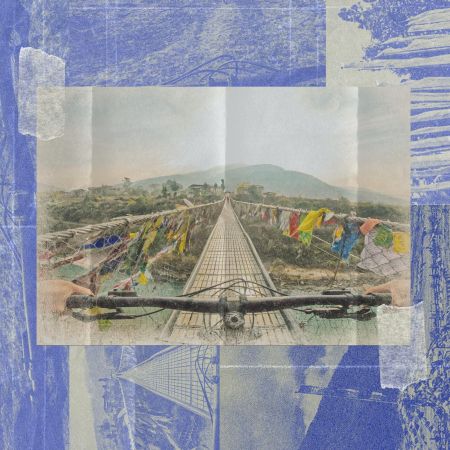This article is part of our brand-new Adventureland series, a collection of “how to” field notes from academic experts, modern explorers and endurance athletes throughout the world. From escaping bears to crossing deserts, they detail the joys of courting adventure — and their tips for surviving it.
North Devon is a scenic place to soak up the British coast, maybe get a jam and cream scone. But it isn’t exactly a big-wave paradise. “It has nice beaches and is the perfect place to learn to surf, but it never gets very big,” says Andrew Cotton, who grew up surfing there since the age of seven.
Accordingly, Cotton’s dream was to be a professional small wave surfer. After leaving school at the earliest opportunity, he surfed every chance he got, while working for a surfboard manufacturer called Gulf Stream Surfboards — a job that allowed him to travel with the company team to places like Hawaii. It was here that Cotton first fell in love with the allure of a bigger wave.
“The Gulf Stream team were better technical surfers than me, but when the waves got bigger it leveled the playing field,” Cotton recalls, speaking on the phone from Portugal. “It suited my sort of skill set. Smaller waves are all about turning and technical skills. Big waves are about paddling out, catching it and going in a straight line.”
Cotton, who is now sponsored by Red Bull and Breitling, helped pioneer big-wave spots in Ireland and has also spent an inordinate amount of time surfing Nazaré, Portugal, renowned for the best breaks in Europe. It was here in 2012 that he towed American surfer Garrett McNamara into what the Guinness Book of World Records confirmed as the biggest wave ever surfed.
It was also in Nazaré, in 2017, that Cotton broke his back after wiping out. Determined not to be sidelined, he fought to return the next year. Then, in 2021, he was featured in HBO’s 100 Foot Wave documentary series, following McNamara as he chased the “Everest of surfing,” the titular 100-foot wave.
Now 44, Cotton is still hunting down the biggest waves on the planet. “The size of a wave is very subjective,” he says. “The first time I rode a big wave I was definitely very scared and felt out of my depth — not ready. But afterwards I remember feeling like: ‘Whoa, that was a fucking win.’ You go through a lot of emotions in surfing; there are a lot of losses, wipeouts and failures and often it’s more of a battle in your mind.”
As for how to win the battle in your mind? Cotton has some advice. We dive his critical do’s and don’ts for big wave surfing below.
The Perfect Surf Vacation for Beginners
You don’t even need to know how to pop up before booking a trip to Kalon Surf on Costa Rica’s Pacific coastlineHow Do I Surf Big Waves?
Surfing big waves isn’t for the faint of heart. Get it wrong, and you could break your back, like Cotton…or even die. Ultimately, it takes years of experience to get ready for big swells. Your heart and mind has to want it, even despite the dangers. If that isn’t you, go practice and come back in a decade. However, if you’re a lifelong surfer and are looking for some expert advice to help you level up, read on.
Become part surfer, part weatherman
“[To find big waves] you need to watch the weather forecasts obsessively,” says Cotton. “There are websites like Surfline that make it simpler, but for the Northern Hemisphere, the big waves come when storm season starts in September/October all the way through to March.”
You’re gonna need a bigger board
“The bigger the wave, the faster it is, so generally you want a bigger board,” says Cotton. “They’re called ‘guns’ and they start at about nine feet. You can get a ‘step up gun’ to help bridge the gap and get you used to it, but a bigger board with more length and volume is definitely a must when riding bigger waves.”
Define your own goals
“A super important thing to get across is that the definition of a big wave is very personal,” says Cotton. It doesn’t have to be 100-foot to be considered a win. Even surfing something a bit bigger than you might usually go for is a step in the right direction. “I can remember my first few big waves at my local beach,” Cotton says. “I was pushing my ability. The first place to master is definitely your local spot.”
Tame your fear
“It’s about baby steps,” Cotton says. “Riding big waves is about confidence building.” In terms of actually catching a wave, Cotton says you need to “follow what your senses are telling you.” “You have to sit under the wave and it’s not a natural place to put yourself,” he says. “It’s about being comfortable in that situation, then having the confidence to turn and paddle and believe that you’re gonna make it.”
Nail your stance
“The classic big wave stances are standing with your feet slightly wider apart and your center of gravity lower,” Cotton says. “The worst things you can do are look at your feet, or stand up straight. As soon as you do that you’ll fall. Look where you want to go, keep low, and point your body in that direction.”
Be safe
“Find a buddy to share the journey with you. It’s about motivation and finding someone to push you,” Cotton says. “But it’s also about safety. The ocean is dangerous. It’s about safety above all else.” That’s to say: don’t go off by yourself. Don’t push it too far. And always surf where there’s a lifeguard, or at least a few of your buddies with a jet-ski or a boat to come and get you should things go wrong.
And should the wave defeat you, there’s no shame in that. Sometimes the very best thing is just floating along, enjoying the scenery from exactly where you already are.
Whether you’re looking to get into shape, or just get out of a funk, The Charge has got you covered. Sign up for our new wellness newsletter today.



















